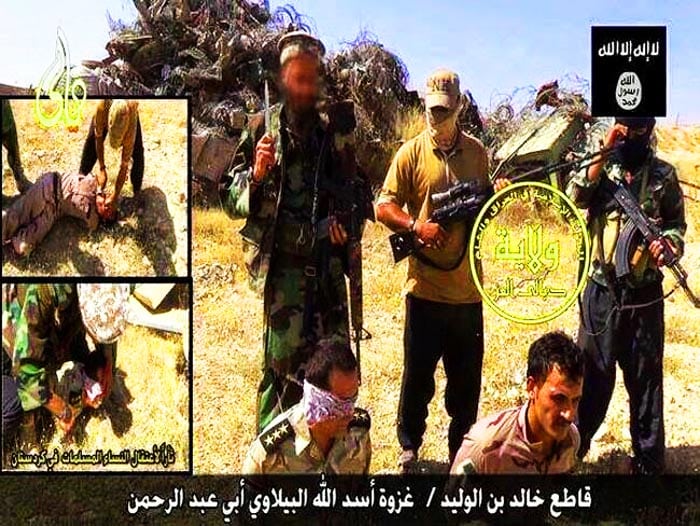 ABC 25 June 2014 Tim Leslie. Mass executions, a terrorist organisation with $2 billion in assets and an army on the run. Just two years after the withdrawal of US troops, Iraq has again been plunged into sectarian-fueled violence and chaos. A copy of the article may be downloaded by clicking on: IRAQ IN CONFLICT
ABC 25 June 2014 Tim Leslie. Mass executions, a terrorist organisation with $2 billion in assets and an army on the run. Just two years after the withdrawal of US troops, Iraq has again been plunged into sectarian-fueled violence and chaos. A copy of the article may be downloaded by clicking on: IRAQ IN CONFLICT
Terrorist group ISIS (Islamic State of Iraq and Syria) has routed the Iraqi army in the north of the country and seized the country’s second largest city. The country, which was invaded by a coalition led by the US in 2003, has been riven along religious and ethnic lines for the past decade and faces an uncertain future. At the heart of the conflict is distrust between the two branches of Islam in the country – Sunni and Shia – a divide replicated throughout the Middle East.
Originally a splinter group from the Iraq chapter of Al Qaeda, ISIS has benefited from unrest in Syria and the deep mistrust which Iraq’s Sunni minority feels towards the central Shia-dominated government. Bolstered by support from the Sunni tribal leaders in northern Iraq, and the disbanding of the largely Sunni Saddam-era armed forces, ISIS entered the conflict in Syria and quickly gained a reputation for brutality and effectiveness.
It used this experience to return to northern Iraq, launching a series of attacks culminating in taking the northern hub of Mosul, Iraq’s second largest city. ISIS holds cities and towns right up to the outskirts of Baghdad and currently controls a vast swathe of territory across Iraq and Syria. While its presence remains largely limited to Iraq and Syria, the ultimate objective is the establishment of an extremist Islamic state across the region, incorporating Syria, Iraq, Jordan, Lebanon, Israel and the Palestinian Territories.Despite being backed by billions of dollars in US military aid, the central armed forces of Iraq have proved largely ineffective against ISIS, and have allowed it within a stone’s throw of the capital of Baghdad.
ISIS gained control of Sunni strongholds Fallujah and Ramadi in January, and Abu Ghraib, just 30 kilometres from Baghdad, in April, releasing hundreds of prisoners held there. The Iraqi government, led by Nouri al-Maliki, has been caught flat-footed by the onslaught, with new intelligence emerging indicating ISIS has over $2 billion in cash and weaponry. While Baghdad is unlikely to fall, the conflict is beginning to take on the dimensions of a civil war, as was the case in 2006 before the US troop surge returned some sense of order to the country. The Iraqi army has begun a counter-attack aimed at pushing ISIS back from the capital, but faces the prospect of a largely unsympathetic Sunni population in the ISIS-occupied areas.
To the north, Iraq’s Kurdish population has seized the opportunity to fill the vacuum left by the Iraqi army, with its militia making advances into ISIS-held territory. The Kurds have been at loggerheads with the central Iraqi government over the extent of their territorial claims, and there is a strong desire for independence from the rest of Iraq.
The prize for the Kurdish semi-autonomous government is Kirkuk, the historic capital of the Kurds in Iraq, and the area’s oil fields, which are among the most lucrative in the country. While the Maliki government may in the long-term be successful in seeing off the ISIS threat, it will face a strengthened Kurdish region unwilling to release its gains.
While pitched battles are being fought outside the capital, in the largely Shia provinces in the south-east of the country there is no major threat to the central government. This area is home to the most densely populated areas in Iraq, as well as 75 per cent of the country’s oil production, and has served to minimise the impact of the conflict on global oil markets.
Over 2.5 million barrels of oil are shipped out of the southern port near Basra every day, and the country’s main area of oil exploration to the north is likely to remain in Kurdish hands. The only major refinery in ISIS-held areas, situated outside Baiji to the north of Tikrit, remains in government hands. The main impact the unrest is likely to have on the industry is the continued closure of a major pipeline that can deliver 600,000 barrels of oil per day to Turkey. The pipeline was sabotaged in March and authorities had hoped to have it repaired shortly before the conflict escalated.
The conflict raises awkward questions of responsibility for the international community, with the Obama administration and other leaders anxious to avoid returning troops to Iraq. Despite public denials of culpability, notably from former British prime minister Tony Blair, it is widely accepted that the seeds of the conflict were sewn during the 2003 invasion and the occupation which followed.
ISIS’s presence in Syria, and grand regional ambitions, also add a new dimension to the Syrian conflict, which is entering its fourth year with no sign of resolution. It has also made for some strange diplomatic alignments, with the US and Iran looking to enter dialogue on how to best deal with the unrest in Iraq, a watershed moment considering their mutual hostility. Whatever is decided internationally, the future looks bleak for Iraq as a nation, as calls grow for the country to split into three along ethnic lines.
http://www.abc.net.au/news/2014-06-17/iraq-conflict-in-maps/5528992
